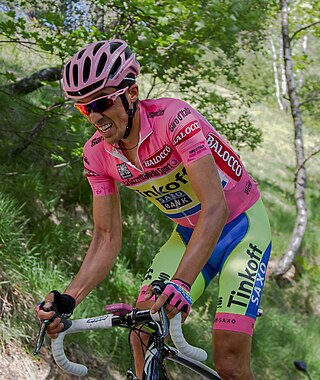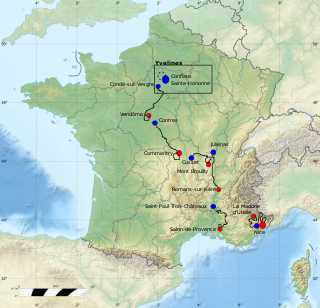
Simon Gerrans is an Australian former professional road bicycle racer, who rode professionally between 2005 and 2018, for the AG2R Prévoyance, Crédit Agricole, Cervélo TestTeam, Team Sky, Orica–Scott and BMC Racing Team squads. Post-retirement he initially worked as an athlete intern at Goldman Sachs in London, then joined The Service Course, in which he is an investor, as COO and now CEO, in early 2020. He can also be heard commentating road cycling for ASO and SBS.

The 2013 Tour de France was the 100th edition of the Tour de France, one of cycling's Grand Tours. It started on the island of Corsica on 29 June and finished on the Champs-Élysées in Paris on 21 July. The Tour consisted of twenty-one stages and covered a total distance of 3,403.5 km (2,115 mi). The overall general classification was won by Chris Froome of Team Sky. Second and third respectively were Nairo Quintana and the Team Katusha rider Joaquim Rodríguez.

Simon Clarke is an Australian professional road racing cyclist, who currently rides for UCI WorldTeam Israel–Premier Tech. He previously rode for the Astana (2011) and Orica–GreenEDGE (2012–2015) teams in the UCI World Tour. Before turning professional, Clarke competed in track cycling as an Australian Institute of Sport scholarship holder. He is not related to fellow Australian cyclist and past teammate Will Clarke.

Team Jayco–AlUla is an Australian professional road race cycling team. Launched in January 2011, it competes at UCI WorldTeam level. The team was formed under the management of Andrew Ryan and Shayne Bannan, with Neil Stephens and Matt White as Sporting Directors. The team rides Giant bicycles, and wear Giordana Cycling clothing and Scott eyewear.
The 2013 Santos Tour Down Under was the 15th edition of the Tour Down Under stage race. It took place from 22 to 27 January in and around Adelaide, South Australia, and was the first race of the 2013 UCI World Tour.

The 2013 Tour of the Basque Country was the 53rd running of the Tour of the Basque Country cycling stage race. It started on 1 April in Elgoibar and ended on 6 April in Beasain, and consisted of six stages, including a race-concluding individual time trial. It was the ninth race of the 2013 UCI World Tour season.
The 2014 Santos Tour Down Under was the 16th edition of the Tour Down Under stage race. It took place from 21 to 26 January in and around Adelaide, South Australia, and was the first race of the 2014 UCI World Tour.

The 2015 Giro d'Italia was a three-week Grand Tour cycling stage race that took place in May 2015. It was the 98th running of the Giro d'Italia and took place principally in Italy, although some stages visited France and Switzerland. The 3,481.8-kilometre (2,163.5 mi) race included 21 stages, beginning in San Lorenzo al Mare on 9 May and concluding in Milan on 31 May. It was the fifteenth race of the 2015 UCI World Tour. The Giro was won by Alberto Contador (Tinkoff–Saxo), with Fabio Aru (Astana) second and Aru's teammate Mikel Landa third.

The 2015 Paris–Nice was the 73rd edition of the Paris–Nice stage race. It took place from 8 to 15 March and was the second race of the 2015 UCI World Tour following the Tour Down Under. The race was a return to the traditional format of Paris−Nice after an unorthodox course in 2014. It started in Yvelines, west of Paris, with a prologue time trial; the course then moved south through France with several stages suitable for sprinters. The decisive part of the race began on stage four with a summit finish at the Col de la Croix de Chaubouret; stage six also had a mountainous route. The race ended after seven days with the climb of the Col d'Èze outside Nice.

The 2015 Liège–Bastogne–Liège was a one-day cycling classic that took place in the Belgian Ardennes on 26 April 2015. It was the 101st edition of the Liège–Bastogne–Liège one-day cycling race and was the fourth cycling monument of the 2015 season. It was part of the 2015 UCI World Tour and was organised by the Amaury Sport Organisation (ASO), the organisers of the Tour de France.
The 2015 Strade Bianche was the ninth edition of the Strade Bianche road cycling race. Held on 7 March 2015, it started in San Gimignano and ended 200 kilometres away in Siena. It was a 1.HC-ranked race that was part of the 2015 UCI Europe Tour.
The 2016 Gent–Wevelgem, was a one-day cycling classic that took place on 27 March 2016. It was the 78th edition of the Gent–Wevelgem race and the seventh event of the 2016 UCI World Tour. The race followed a 243-kilometre (151 mi) course that started in Deinze and ended in Wevelgem in Belgium, with a portion of the race spent in northern France. The race included ten climbs, several of them cobbled, which provided the principal difficulty in the race. The last and most difficult climb was the Kemmelberg. The favourites for the race included Alexander Kristoff, Fabian Cancellara (Trek–Segafredo), and Peter Sagan (Tinkoff).

The 2016 Paris–Nice was a road cycling stage race that took place in France between 6 and 13 March 2016. It was the 74th edition of the Paris–Nice and was the second event of the 2016 UCI World Tour.
The 2016 Tour of the Basque Country was a road cycling stage race that took place in the Basque Country between 4 and 9 April 2016. It was the 56th edition of the Tour of the Basque Country and the ninth event of the 2016 UCI World Tour.
The 2016 Tour de Romandie was a road cycling stage race that took place in the Romandie region of Switzerland between 26 April and 1 May 2016. It was the 70th edition of the Tour de Romandie cycling stage race and the 14th event in the 2016 UCI World Tour. The defending champion was Team Katusha's Ilnur Zakarin.
The 2016 Tour de San Luis was a road cycling stage race that took place in Argentina between 18 and 24 January 2016. It was the tenth edition of the Tour de San Luis. The race was used by many European-based riders as the beginning of their 2016 road seasons. It was rated as a 2.1 event as part of the 2016 UCI America Tour. The defending champion is the Argentine cyclist Daniel Díaz.
The 2016 Herald Sun Tour was a road cycling stage race that took place in Victoria, Australia, between 3 and 7 February 2016. The race was rated as a 2.1 event as part of the 2016 UCI Oceania Tour.
The 2016 Volta a Catalunya was a road cycling stage race that took place in Catalonia, Spain, from 21 to 27 March. It was the fifth race of the 2016 UCI World Tour and the 96th edition of the Volta a Catalunya.

The 2016 Liège–Bastogne–Liège was a one-day classic cycling race that took place on 24 April 2016. It was the fourth cycling monument of the 2016 season and was the thirteenth event of the 2016 UCI World Tour. The race came at the end of the spring classics season.
The 2016 Amstel Gold Race was a one-day classic cycling race that took place in the Limburg region of the Netherlands on 17 April 2016. It was the 51st edition of the Amstel Gold Race and the eleventh event of the 2016 UCI World Tour. It was also the first of the Ardennes classics, although it is technically not in the Ardennes region. The race took place over a 258-kilometre (160 mi) route that starts in Maastricht and ends in Berg en Terblijt on the outskirts of Valkenburg. The key difficulty in the race came from the 34 short but steep climbs. The central climb, the Cauberg, was crossed four times, with 1.8 kilometres (1.1 mi) between the final summit and the finish line. The favourites for victory in the race included the three-time winner Philippe Gilbert (BMC), the defending champion Michał Kwiatkowski (Sky), and Simon Gerrans and Michael Matthews.










